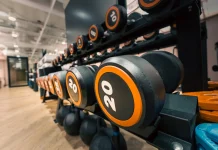Last Updated on January 27, 2025
If you’re looking to build lower body strength, improve coordination, and add a functional movement to your workout routine, step-ups with barbell is an excellent choice. This compound exercise targets your quads, glutes, hamstrings, and calves while also engaging your core and improving balance. Whether you’re an athlete, a fitness enthusiast, or someone just starting out, barbell step-ups can be tailored to your fitness level and goals. Let’s dive into how to perform this exercise correctly, its benefits, and tips to maximize your results.
How to Perform Step-Ups with Barbell
What You’ll Need:
- A sturdy bench, box, or step (ensure it’s stable and can support your weight).
- A barbell with appropriate weight (start light and gradually increase as you build confidence).
Step-by-Step Instructions:
- Set Up Your Equipment:
Place the bench or box in front of you. Make sure it’s at a height that challenges you but allows you to maintain proper form. For beginners, a lower height is recommended. - Position the Barbell:
Grasp the barbell with a wide grip and carefully place it across your upper back, resting it on your trapezius muscles (similar to a back squat position). Keep your chest up, shoulders back, and core engaged. - Step Up with Your Left Leg:
Begin by stepping onto the bench with your left leg. Press through your left heel to lift your body up, ensuring your leg does the work rather than relying on momentum. - Follow with Your Right Leg:
Once your left leg is fully extended, bring your right leg up to meet it on the bench. Stand tall at the top of the movement, balancing on both feet. - Step Down with Control:
Reverse the movement by stepping down with your left leg first, followed by your right leg. Maintain control throughout the descent to avoid jarring your joints. - Repeat, Starting with Your Right Leg:
Alternate the leading leg with each repetition to ensure balanced muscle development. For example, if you started with your left leg on the first rep, start with your right leg on the next rep.
Key Tips for Success
- Start Light: If you’re new to this exercise, use a lighter weight or even just your body weight until you’re comfortable with the movement pattern.
- Focus on Form: Keep your chest up, core tight, and avoid leaning forward as you step up. Your leading leg should be doing the majority of the work.
- Control the Movement: Avoid rushing through the exercise. Slow, controlled movements will maximize muscle engagement and reduce the risk of injury.
- Choose the Right Height: The bench or box should be high enough to challenge you but not so high that you compromise your form. A good starting point is knee height or slightly lower.
- Warm Up First: Perform a dynamic warm-up to prepare your legs and core for the exercise. Lunges, bodyweight squats, and hip openers are great options.
Benefits of Barbell Step-Ups
- Builds Lower Body Strength:
This exercise targets your quads, glutes, hamstrings, and calves, helping you develop strong, powerful legs. - Improves Coordination and Balance:
Step-ups require you to stabilize your body as you move, which enhances your balance and coordination over time. - Functional Fitness:
The movement mimics everyday activities like climbing stairs or stepping over obstacles, making it a practical addition to your routine. - Unilateral Training:
By working one leg at a time, you can identify and address muscle imbalances, ensuring both sides of your body are equally strong. - Core Engagement:
Keeping your torso upright and stable during the exercise engages your core muscles, contributing to better overall strength and posture.
Variations to Keep It Challenging
Once you’ve mastered the basic barbell step-up, try these variations to keep your workouts fresh and challenging:
- Dumbbell Step-Ups: Hold a dumbbell in each hand instead of using a barbell for a different grip and stability challenge.
- Weighted Vest Step-Ups: Add a weighted vest to increase resistance while keeping your hands free.
- Lateral Step-Ups: Step onto the bench from the side to target your muscles from a different angle.
- Plyometric Step-Ups: Add an explosive jump as you step up to incorporate power training.
Common Mistakes to Avoid
- Using Too Much Weight Too Soon: This can compromise your form and increase the risk of injury. Focus on mastering the movement before adding heavy weight.
- Leaning Forward: Keep your torso upright to ensure your legs are doing the work and to protect your lower back.
- Rushing the Movement: Slow and controlled reps are more effective than fast, sloppy ones.
- Neglecting the Eccentric Phase: Don’t just drop down from the bench—control your descent to maximize muscle engagement.
Incorporating Barbell Step-Ups into Your Routine
Barbell step-ups can be incorporated into your leg day or full-body workouts. Here’s a sample workout structure:
- Warm-Up: 5-10 minutes of dynamic stretching or light cardio.
- Barbell Step-Ups: 3 sets of 8-12 reps per leg.
- Pair with Other Exercises: Combine step-ups with squats, deadlifts, or lunges for a comprehensive lower body workout.
- Cool Down: Stretch your quads, hamstrings, and glutes to improve flexibility and recovery.
Final Thoughts
Barbell step-ups are a versatile and effective exercise that can help you build strength, improve coordination, and enhance functional fitness. Whether you’re a beginner or an experienced lifter, this movement can be adapted to suit your needs and goals. Remember to prioritize proper form, start with lighter weights, and gradually increase the intensity as you progress. Add barbell step-ups to your routine, and you’ll be stepping up your fitness game in no time!
What’s your favorite variation of step-ups? Share your thoughts and experiences in the comments below!






